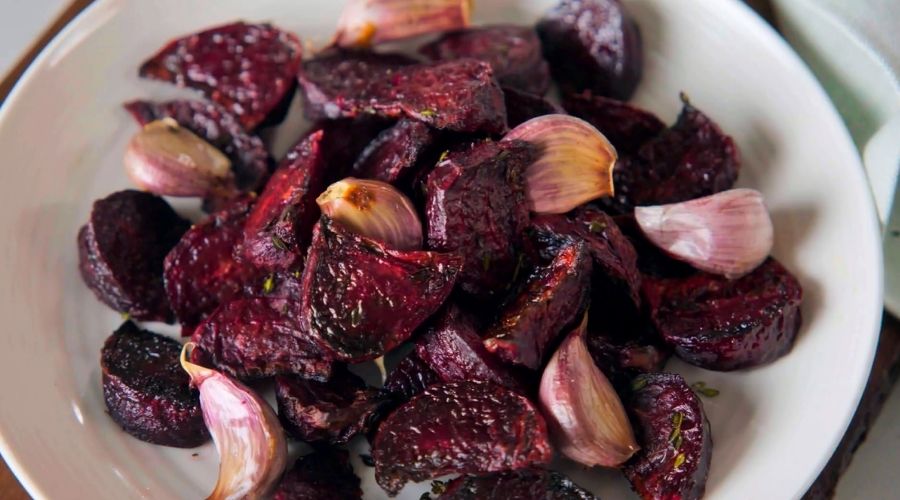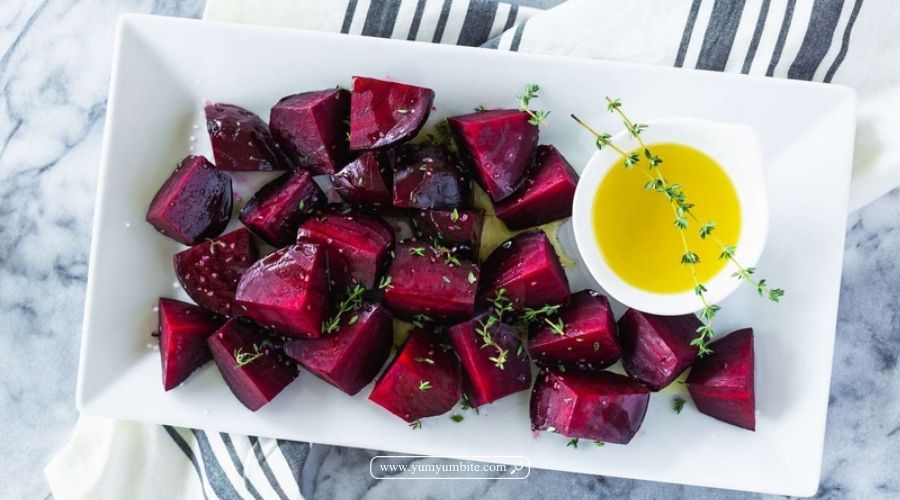Cooked beetroot is a delicious and nutritious addition to various dishes, from salads to smoothies.
However, knowing how to store it properly is crucial to maintain its vibrant color, rich flavor, and health benefits.
Improper storage can lead to spoilage, resulting in a waste of this nutritious vegetable.
In this article, we will explore the best practices for storing cooked beetroot, ensuring that you can enjoy its unique taste and nutritional value long after it has been prepared.
Whether you’re looking to refrigerate leftovers or freeze a batch for future use, we’ve got you covered with tips and techniques to keep your cooked beetroot fresh and flavorful.
Why Storing Cooked Beetroot Properly Matters
Storing cooked beetroot properly is essential for maintaining its vibrant color, rich flavor, and nutritional benefits.
This root vegetable is known for its earthy taste and numerous health advantages, including being a great source of vitamins, minerals, and antioxidants.
However, improper storage can lead to spoilage, resulting in a loss of texture and taste, as well as the potential growth of harmful bacteria.
By employing the right storage techniques, you can extend the shelf life of cooked beetroot while preserving its quality.
Proper storage not only helps reduce food waste but also ensures that you can enjoy this nutritious vegetable in a variety of dishes, from salads to smoothies.
Understanding how to store cooked beetroot effectively guarantees that you reap its full health benefits and enjoy its unique flavor long after it has been prepared.
Complete Guide on How to Store Cooked Beetroot

Storing cooked beetroot correctly is crucial for maintaining its flavor, texture, and nutritional value.
Here’s a comprehensive guide to help you store this vibrant vegetable effectively.
1. Allow It to Cool
After cooking, let the beetroot cool at room temperature for about 30 minutes.
This cooling period is important, as placing hot beetroot directly into a storage container can create moisture, leading to spoilage.
2. Choose the Right Storage Container
Select an airtight container that can effectively seal out air and moisture. Glass or BPA-free plastic containers are ideal, as they help maintain the freshness of the beetroot.
If you don’t have a container, you can tightly wrap the beetroot in plastic wrap or aluminum foil.
3. Refrigerate for Short-Term Storage
For short-term storage, place the covered cooked beetroot in the refrigerator. It can typically last for about 3 to 5 days when stored this way.
Make sure the refrigerator temperature is consistently below 40°F (4°C) to prevent spoilage.
4. Freeze for Long-Term Storage
If you want to store cooked beetroot for a longer period, freezing is an excellent option.
Once cooled completely, cut the beetroot into slices or cubes to make it easier to use later.
Transfer the pieces to an airtight freezer-safe container or a heavy-duty freezer bag, ensuring to remove as much air as possible.
Label the container with the date, and it can be stored in the freezer for up to 3 months.
5. Reheating Before Serving
When you’re ready to enjoy your stored beetroot, you can reheat it in the microwave or oven.
For microwave reheating, place the beetroot in a microwave-safe dish and cover it to retain moisture.
If using the oven, preheat to 350°F (175°C), place the beetroot in an oven-safe dish, and heat for about 10-15 minutes until warmed through.
6. Check for Freshness
Before consuming stored cooked beetroot, check for any signs of spoilage. Look for off smells, unusual textures, or discoloration.
If anything seems off, it’s safer to discard it.
By following these steps, you can ensure that your cooked beetroot remains fresh and flavorful, ready to enhance your meals in the days to come.
Proper storage techniques not only improve your culinary experience but also help reduce waste, making the most of this nutritious vegetable.
What to Look for While Storing Cooked Beetroot

When storing cooked beetroot, there are several important factors to consider to ensure its freshness and quality.
First, allow the beetroot to cool completely at room temperature before placing it in a storage container.
This cooling step is crucial, as residual heat can lead to condensation, promoting spoilage.
Choose an appropriate storage container that is airtight, such as glass or BPA-free plastic, to effectively keep out air and moisture.
If using plastic wrap or aluminum foil, make sure to wrap the beetroot tightly to minimize exposure.
Consider the storage environment as well. For short-term use, refrigerate the cooked beetroot, ensuring the temperature is consistently below 40°F (4°C).
If you plan to keep it longer, freezing is an excellent option. When freezing, cut the beetroot into manageable pieces to facilitate future use.
Lastly, always check the cooked beetroot for signs of spoilage before consumption. Look for off smells, unusual textures, or discoloration, and if anything seems amiss, it’s best to discard it.
By paying attention to these details, you can enjoy your cooked beetroot at its best while maximizing its nutritional benefits.
How to Choose the Right Accessories for Storing Cooked Beetroot
Selecting the right accessories for storing cooked beetroot is essential for maintaining its freshness and flavor.
Here are some key considerations:
1. Airtight Containers
Opt for airtight containers that can effectively seal out air and moisture. Glass containers are ideal as they don’t retain odors and are easy to clean.
BPA-free plastic containers are also a good choice, especially if you prefer lightweight options. Ensure the container is appropriately sized to minimize excess air inside.
2. Plastic Wrap or Aluminum Foil
If you don’t have a suitable container, plastic wrap or aluminum foil can work well to cover the beetroot.
Make sure to wrap it tightly to prevent air exposure, which can lead to spoilage. This option is useful for short-term storage.
3. Freezer Bags
For long-term storage, heavy-duty freezer bags are an excellent accessory. These bags are designed to keep out air and prevent freezer burn.
When using them, remove as much air as possible before sealing, and label them with the date for easy tracking.
4. Labels and Markers
Using labels and a permanent marker helps keep track of storage dates. Clearly label your containers or bags with the date the beetroot was cooked, ensuring you consume it while it’s still fresh.
5. Cooling Racks or Baking Sheets
When cooling your cooked beetroot before storage, consider using a cooling rack or a baking sheet.
Spreading the beetroot out on a rack allows for even cooling, reducing the risk of moisture build-up before sealing it in a container.
By carefully selecting these accessories, you can create an effective storage system for your cooked beetroot, ensuring it remains fresh and flavorful for future meals.
How to Tell If Cooked Beetroot Is Bad After Storing
Determining whether cooked beetroot has gone bad is essential for ensuring food safety and quality.
Here are some signs to look for:
1. Smell
One of the first indicators of spoilage is the smell. Fresh cooked beetroot has a sweet, earthy aroma.
If you detect any sour or unpleasant odors, this is a strong sign that the beetroot has spoiled and should be discarded.
2. Texture
Check the texture of the cooked beetroot. It should remain tender but firm. If the beetroot feels excessively mushy, slimy, or has a gritty texture, these are signs of spoilage.
3. Color
Examine the color of the cooked beetroot. It should retain its vibrant deep red or purple hues.
If you notice significant discoloration, such as browning or dark spots, this may indicate spoilage.
4. Taste
If the beetroot looks and smells fine but you’re still unsure, a small taste test can help. If it tastes off, sour, or has an unusual flavor, it’s best to discard it rather than risk foodborne illness.
5. Storage Duration
Keep track of how long the cooked beetroot has been stored. Ideally, it should be consumed within 3 to 5 days when refrigerated.
If it has been in the fridge longer than this timeframe, it’s safest to throw it away, even if it appears fine.
By being vigilant and checking for these signs, you can ensure that your stored cooked beetroot remains safe and enjoyable to eat.
When in doubt, it’s always better to err on the side of caution!
1. How long can I store cooked beetroot in the refrigerator?
Cooked beetroot can be stored in the refrigerator for about 3 to 5 days. Ensure it is kept in an airtight container to maintain freshness.
2. Can I freeze cooked beetroot?
Yes, you can freeze cooked beetroot. After cooling it completely, cut it into pieces and store it in airtight freezer-safe containers or heavy-duty freezer bags.
It can be stored in the freezer for up to 3 months.
3. Should I cover cooked beetroot before refrigerating?
Yes, it’s important to cover cooked beetroot before refrigerating. Use an airtight container or tightly wrap it with plastic wrap or aluminum foil to prevent air exposure and moisture loss.
4. How do I cool cooked beetroot before storing?
Allow the cooked beetroot to cool at room temperature for about 30 minutes before placing it in a storage container.
This helps prevent moisture buildup inside the container.
5. What’s the best way to reheat stored beetroot?
The best way to reheat cooked beetroot is in the microwave or oven. For the microwave, place it in a microwave-safe dish and cover it.
If using the oven, preheat to 350°F (175°C) and heat for about 10-15 minutes until warmed through.
6. How can I tell if stored beetroot has gone bad?
Signs of spoilage include off smells, unusual textures (such as excessive mushiness), discoloration, or mold.
If you notice any of these signs, it’s best to discard the beetroot.
7. Can I store cooked beetroot in the original cooking pot?
While you can store cooked beetroot in the original pot, it’s best to transfer it to an airtight container or cover it tightly with plastic wrap or foil.
This helps to keep it fresh and prevents unwanted odors from affecting the flavor.
Conclusion
Storing cooked beetroot correctly is essential for preserving its taste, texture, and nutritional benefits.
By following the proper techniques—cooling it adequately, using airtight containers, and choosing the right storage method—you can extend the shelf life of this versatile vegetable.
Proper storage not only enhances your culinary experience but also reduces food waste, allowing you to enjoy the vibrant flavors of cooked beetroot in your meals for days to come.
With these simple steps, you can make the most of your cooked beetroot and savor its deliciousness whenever you desire.
Sources
- https://realfood.tesco.com/curatedlist/ways-to-use-up-leftover-beetroot.html
- https://cookpad.com/ng/search/left%20over%20beet
- https://www.theguardian.com/lifeandstyle/2014/sep/16/28-recipe-ideas-for-leftover-beetroot
- https://www.today.com/recipes/pickled-leftover-roasted-beets-recipe-t215312
- https://app.affpilot.com/editor/1667986


